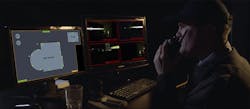When it comes to securing a perimeter, no single technology does it all. Every tool in the toolbox has its strengths and limitations when faced with the unique topology of the environment and the variety of potential threats. That’s why integrators generally recommend that customers deploy a strategic mix of products – from visible light and thermal cameras to motion detection and cross-line analytics to passive infrared and radar sensors.
Visible light cameras and thermal cameras work well at detecting, locating and identifying intruders at the gate and along the perimeter. They can be equipped with advanced features like auto tracking or video motion detection; however, since motion detection relies on visual data, its accuracy dips when operating outdoors and at night.
Thermal cameras, on the other hand, respond to the heat signature of objects rather than visible light, which makes them a good complement to visible light cameras. They are able to detect and distinguish people, vehicles and anomalous activity in shadows, complete darkness or other challenging conditions such as smoke and dust; however, the cost of thermal cameras might be too expensive for some users.
Passive infrared sensors could be a more affordable alternative, but their range is somewhat limited.
Another option now on the market is network radar detector technology which detects based on radio waves. These detectors provide good coverage area and trigger few false alarms, even during nighttime surveillance.
Perimeter Technology Comparison
|
|
VIDEO ANALYTICS |
PASSIVE INFRARED |
THERMAL |
RADAR |
|
Cost |
Medium |
Low |
High |
Medium |
|
Configuration |
Difficult |
Easy |
Medium |
Easy |
|
Light condition |
Day |
Day/Night |
Day/Night |
Day/Night |
|
Coverage |
Wide area Long distance |
Wide area Short distance |
Narrow area Long distance |
Wide area Medium distance |
|
Object information |
Detection Recognition Identification |
Detection |
Detection Recognition |
Detection Speed Distance Angle |
|
False alarm triggers |
Insects Shadows Noise Bad weather |
Insects |
None |
None |
|
Filter on distance |
No |
No |
No |
Yes |
How Network Radar Detectors Work
Network video cameras rely on pixel changes to recognize motion. Network radar detectors, on the other hand, not only detect motion but identify other crucial characteristics of the object creating the motion – whether it is a person, vehicle, animal or something else. They do this by emitting an electromagnetic pulse and analyzing the echo that comes back from the object. Sophisticated algorithms translate this information into the object’s position, distance and speed (towards or away from the radar) as well as the direction of its movement.
The closer and the larger the object, the more energy bounces back. If the object is moving, the returning radio waves shift in frequency – called the Doppler shift. When used in a security application, the radar detector looks at the Doppler shift to determine if there is a moving object in the area that might be of interest.
Types of Radar Detection
There are three different types of radar:
- Continuous Wave (CW) radar can only tell the velocity of a moving object;
- Frequency Shift Keying (FSK) is a more advanced type of radar that can tell the velocity and distance to a moving object; however, it has difficulty establishing that observation if there are several objects in the scene; and
- Frequency-Modulated Continuous-Wave (FMCW) radar is the preferred type of radar for security applications because it can tell the velocity and distance to a large number of moving objects simultaneously.
For most radar detection applications, it is important to know the angle to the object to get an accurate reading. One way to measure the angle is to set up a phased array antenna – multiple antenna elements working together to measure the phase shift that will indicate the object angle.
Ideally, the radar detector should be mounted three to four meters (10-13 feet) above ground, generally at the same height as a surveillance camera.
Integrating Video with Radar
The benefits of network radar include ease of installation, as it only requires a PoE network drop; and ease of integration with other security systems. While network radar detectors are not infallible, integrating their data with network video cameras gives users a way to independently verify motion detection.
Rules can then be established that state that only when both detectors (video and radar) agree there has been motion in the area of interest will a positive motion detection alarm be transmitted to the operator or central monitoring station along with detailed information about the object in motion. This collaborative validation can achieve significant cost savings by reducing false alarms and diversion of valuable resources to respond to non-events.
Setting Realistic Expectations
Radar detectors work in complete darkness as well as bright sunlight and they are not affected by shadows and other light phenomena. They work in wind, snow, rain, fog and smog, although heavy rain may slightly reduce the maximum detection range, typically 164 feet or 50 meters.
Another advantage is that unlike surveillance cameras, their performance cannot be compromised by spiders and insects. Because they can also measure distance, they can be programmed to ignore known objects at certain distance such as bushes, trees, flags and flagpoles.
When integrated with network PTZ cameras, network radar detectors can point the cameras auto-tracking feature in the right direction. Like network cameras, network radar detectors can be programmed to include or exclude specific zones and trigger different actions – sirens, floodlights, loudspeaker announcements, video recording and alerts to security personnel.
There are, however, some circumstances where their performance can be less than optimal. For example, grass and other vegetation can mask the motion of very slow-moving objects such as a person crawling. Additionally, if too many radar detectors are mounted too closely in the same area, their transmission signals could interfere with one another.
Target Markets
With a typical detection range of 50 meters and typically a 120-degree field of view, network radar detectors are optimal for monitoring medium-risk installations such as small, outdoor construction sites, warehouses or schools. Because of their reliability under challenging conditions they can detect incidents that cameras might miss and filter out irrelevant movement that might otherwise trigger false alarms.
Fredrik Nilsson is the VP, Americas, for Axis Communications. He is the author of “Intelligent Network Video: Understanding Modern Video Surveillance Systems” published by CRC Press and now available in its second edition. Request more info about Axis at www.securityinfowatch.com/10212966.
About the Author

Fredrik Nilsson
Fredrik Nilsson is VP Americas for Axis Communications, and is the author of “Intelligent Network Video: Understanding Modern Video Surveillance Systems” published by CRC Press and now in its second edition. www.axis.com
Request more info about Axis at www.securityinfowatch.com/10212966.
